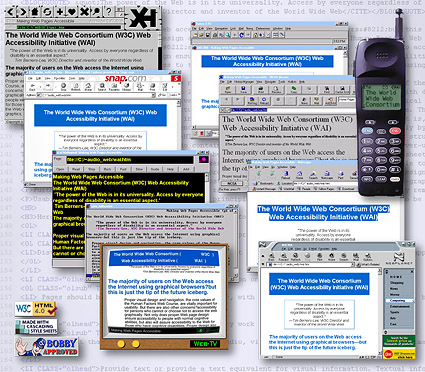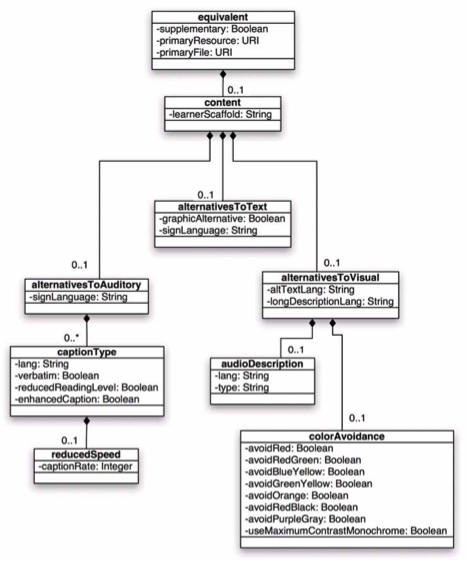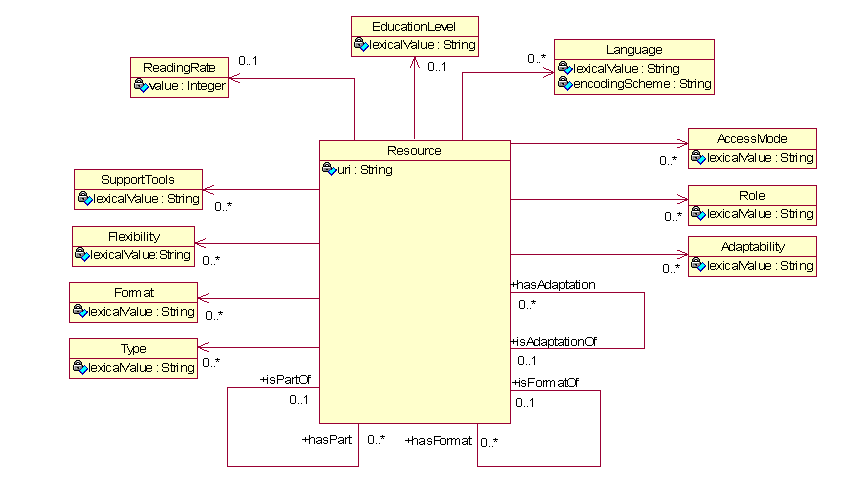What do we need to know about an object to be able to access it?
Site Navigation
Contents of Thesis ack'ments - Introduction - Context - Accessibility - W3C/WAI - LitReview - Metadata - Accessibility Metadata - PNP - DRD - Matching - UI profiles - Interoperability - Framework - Implementation - Conclusion - References - Appendix 1 - Appendix 2 - Appendix 3 - Appendix 4 - Appendix 5 - Appendix 6 - Appendix 7

What
do we need to know about an object to be able to access it?
The AccessForAll specifications are intended to address mismatches between resources and user needs caused by any number of circumstances including requirements related to client devices, environments, language proficiency or abilities. They support the matching of users and resources despite [accessibility] short-comings in resources. These profiles allow for finer than usual detail with respect to embedded objects and for the replacement of objects where the originals are not suitable on a case-by-case basis. The AccessForAll specifications are not judgmental but informative; their purpose is not to point out flaws in content objects but to facilitate the discovery and use of the most appropriate content for each user (Jackl, 2004).
The AccessForAll specifications are part of the AccessForAll Framework. They do not specify what does or does not qualify as an accessible Web page but are designed to enable a matching process that, at best, can get functional specifications from an individual user and compose and deliver a version of a requested resource that meets those specifications. It depends upon other specifications for the accessible design of the components and services it uses.
Having a common language to describe the user's needs and preferences and a resource's accessibility characteristics is essential to this process. That is why the resource descriptions proposed below so closely match the descriptions of the needs and preferences of individual users. It is not essential, however, for there to be a matching process for there to be value in having a good description of the accessibility characteristics of a resource. In the discovery and selection processes, a user can take advantage of such a description and at least be forewarned about the resource.
It should be clear that, as AccessForAll does not specify the functional characteristics of Web content, but rather the specifications for the description of those characteristics, it is not intended to support any claims of conformance of resources to other standards and specifically, not conformance to the WCAG specifications. On the other hand, the WCAG specifications might well be used to determine the characteristics of the resource, such as if the text is well-constructed, or if images have correct alternatives. AccessForAll specifications are only concerned with metadata.
A significant amount of the content in this chapter has been published in papers written by the author (Nevile, 2005a) or in documents to which the author contributed (Barstow & Rothberg, 2002; Jackl, 2004; Chapman et al, 2006).
The AfA way of organising metadata has to take into account that most resources are thought of as having a set form with modifications for accessibility purposes. This is not an inclusive way of thinking of resources, and it is not what is emerging as the model on the Web. Given the technology, resources are being formed at the time of delivery, according to the delivery mechanisms available and the point of delivery, but often resulting in many very different manifestations. AfA is designed to contribute to, in fact take advantage of, that process.
Matching users and resources involves not only the user's needs and preferences from a personal perspective, but also accommodations for their access devices. The following image shows the same Web page rendered by 10 different access devices, not including any that don't produce visual displays of any kind:

from http://www.humanfactors.com/downloads/accessibletesting.asp accessed
15/1/2005.
AfA metadata is also designed to facilitate the just-in-time adaptation of resources to make them accessible for individuals. This process depends on metadata being available so it can be used to manage the substitution, complementing or adaptation of a resource or some of its components.
Given that most resource publishers do not know much about accessibility, and have been shown to not do much about it, it is assumed they will not be very careful about what metadata they contribute to resources, if any. For this reason, there has been an effort to find the minimum that makes a difference and is easy to write, with the hope that those who do more about accessibility, either making better resources or fixing others, are more inclined and better informed about what metadata to use. In cases where there is a resource that contains or is intimately linked to alternatives, such as where there is an equivalent resource like a text caption for an image, the metadata for the resource should indicate this and provide metadata for both versions of that component. It may be necessary for one component to be thought of as the 'primary' component and for the other to be the equivalent alternative.
Equivalent alternative resources are of two types: supplementary and non-supplementary. A supplementary alternative resource is meant to augment or supplement the primary resource, while a non-supplementary alternative resource is meant to substitute for the primary resource. Although in most cases the primary and equivalent alternative resources will be separate, a primary resource may contain a supplementary alternative resource. For example, a primary video could have text captions included. In this case the resource would be classified as primary containing an equivalent supplement. A primary resource can never contain, within itself, a non-supplementary resource (Jackl, 2004, Sec. 3.2.1 Equivalent Alternative Resource Meta-data).
The AfA metadata is tightly specified and very detailed. This is not done in ignorance of the practicalities of metadata that suggest it should be very light-weight, easy to create, etc.. It is this way because people with disabilities have special needs. They use technologies that are built specially for them and that means for a small market given the range of different devices they need. This does not mean that the market for standardised accessibility metadata is small - it can be shared across all the different assistive technologies and beyond them to great benefit. It means rather that it is very important to be very precise about the metadata and to maintain its stability very carefully so that assistive technology device and software developers can be assured of the stability of the functional requirements for metadata and thus reliable availability of that metadata. There is not the usual room for tolerance when not having something means having no access to information for someone. Thus, the threshold for interoperability is high in this context.
The personal access systems used by people with disabilities can be seen as unique external systems that need to interoperate with the system delivering the resource. These personal access systems must interoperate with many different delivery systems. The personal access systems must also adjust frequently to updates or modifications in an array of delivery systems. For these reasons it is important that the delivery systems tightly adhere to a common set of specifications with information relevant to accessibility. To promote interoperability this information should be found in a known consistent place, stated using a consistent vocabulary and structured in a consistent way. To support this critical interoperability the AccessForAll specifications offer less flexibility in implementation than other specifications (Jackl, 2004, Sec. 3.2.4 The Importance of Interoperability for Accessibility).
The WCAG architecture treats resources as single entities despite the fact that it may take a number of files to form a Web page. This is not the way resources are understood in AfA architecture:
Content can be considered either atomic or aggregate. An atomic resource is a stand-alone resource with no dependencies on other content. For example, a JPEG image would be considered an atomic resource. An aggregate resource, however, is dependent on other content in that it consists not only of its own content but also embeds other pieces of content within itself via a reference or meta-data. For example, an HTML document referencing one or more JPEG images would be considered an aggregate resource. The use and behavior of AccessForAll Meta-data for atomic content is straightforward. .... For aggregate content, the required system behavior is slightly more complex but it still involves matching. In other words, if the primary resource is an aggregate resource, then the system will have to determine whether or not the primary resource contains atomic content that will not pass the matching test. If so, it will examine the inaccessible atomic resources to determine which resources require equivalents. This means a primary resource must define its modalities as inclusive of those of its content dependencies (Barstow & Rothberg, 2002).
As the required metadata is quite detailed, there may be some concern about who will produce it. Even where the metadata is created by a well-intentioned party, there may be a question about how reliable it is. Fortunately, there are a number of applications available that help with the description process and even do some of it automatically.
There are a number of tools for the authoring of metadata but, in the accessibility context, there are tools for assessing accessibility that also produce metadata. Many of these produce their reports in a language called Evaluation and Report Language [EARL]. EARL provides a way to encode metadata such as AfA metadata. EARL requires all statements to be identified with a time and the person or agent making them. This makes it easier to identify the source of the description for trust purposes. EARL statements are generally intended to convey information about compliance to some stated standard or specification. This information is typical of what is needed for accessibility. An example is an EARL statement that includes information about the transformability of text determined by reference to the relevant WCAG provisions.
The original IMS AccessForAll specifications were very closely based on the specifications developed by the ATRC for TILE. These were subjected to rigorous scrutiny because of the need to satisfy the other stakeholders involved but the attributes of interest were assumed to have been well-identified by the ATRC. As those specifications were advanced through the ISO/IEC process, they were subjected to scrutiny and some modifications were made. These are not important in the sense that they are details about attributes that can be adapted and adopted within the framework. What is important is how the framework operates and how the specifications work.
Just as the user will want to define three classes of attributes of digital resources, there are three classes of attributes to be described using AfA metadata. They are the control, display and content characteristics.

from 2.3, Page 7, AccMD Norton, 2004
As can be seen in Fig ????, the original structure of this metadata was deeply hierarchical. Somehow, it needed also to be represented as 'flat' Dublin Core metadata. This was achieved by using the DC structures but only interoperable with the assistance of cross walks. 'Depth', in Dublin Core metadata, is achieved by having qualifications of elements that comply with DC rulesfor such qualifiers. DC qualifiers constrain either the element itself or the potential values of those elements, by providing such as an encoding scheme or a controlled vocabulary.

DC Accessibility model (full size version in ch
????)
The author considered the hierarchical model of the IMS version and developed an equivalent version according to the DC model. The two hierarchies (Appendix 7), allowing for all the information that is available for an IMS profile to ensure it would also be available in a DC profile. So long as this is done correctly, that is, so long as the DC rules for elements and application profiles are observed, the metadata can be encoded in a number of ways, particularly in HTML, XML and RDF(XML).
The available DC rules state:
At the time of the ratification of this document, the DCMI recognizes two broad classes of qualifiers:
Element Refinement. These qualifiers make the meaning of an element narrower or more specific. A refined element shares the meaning of the unqualified element, but with a more restricted scope. A client that does not understand a specific element refinement term should be able to ignore the qualifier and treat the metadata value as if it were an unqualified (broader) element. The definitions of element refinement terms for qualifiers must be publicly available.
Encoding Scheme. These qualifiers identify schemes that aid in the interpretation of an element value. These schemes include controlled vocabularies and formal notations or parsing rules. A value expressed using an encoding scheme will thus be a token selected from a controlled vocabulary (e.g., a term from a classification system or set of subject headings) or a string formatted in accordance with a formal notation (e.g., "2000-01-01" as the standard expression of a date). If an encoding scheme is not understood by a client or agent, the value may still be useful to a human reader. The definitive description of an encoding scheme for qualifiers must be clearly identified and available for public use (DCMI, 2000)
Originally, qualifiers of elements were explicitly declared with a syntax of the type DC:<term>:<qualifier> but now they are just used as terms as in DC.<Qualifier>. This does not mean they do not follow the rules, but once this is established, they are used alone. That a term is a qualification of another is of significance when the metadata is being transformed for some purpose: a qualified term's value must make sense as the term's value, according to what is called the dumb-down rule. This often introduces some loss of specificity, but at least means that the information can be transferred without loss. It also accommodates what might otherwise be hierarchically structured information.
One of the significant outstanding challenges for the metadata work is how to use these new specifications when it is not clear what the alternatives are and so a search is required to locate suitable alternatives. It is envisaged that the specification of display and control characteristics will not be a problem beyond the existence or otherwise of the necessary metadata but finding suitable alternative content may be a challenge. TILE has so far only worked with content that has been developed with accessibility in mind and so guarantees the availability of the necessary combinations of components.
Typical problems for the discovery of suitable content are exemplified by two scenarios:
and